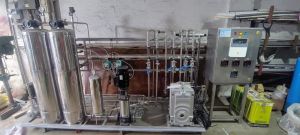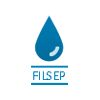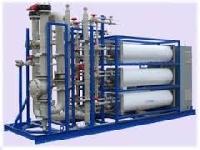
Electrodeionization Plant
449,500 - 450,000 Per piece
1 Piece (MOQ)
Electrodeionization (EDI) is used after reverse osmosis for polishing of demineralized water to obtain low levels of conductivity and silica. The EDI uses ion exchange membranes, ion exchange resins and electricity to produce high-quality water with no regeneration downtime. EDI is an alternative to a conventional mixed bed polisher. Electrodeionization System (RO EDI Plant) technique can achiever high purity of Deionized water with conductivity less than 0.1 μS/cm.EDI advantages CONTINUOUS PROCESS : EDI provides a simple and continuous operation with no downtime due to the electrochemical regeneration. NO USE OF CHEMICALS : EDI utilizes chemical-free regeneration. Therefore, no storage or application of chemicals is required. SPACE-SAVING PLANTS : The EDI plants are space-saving due to the very compact design. Typical Applications of EDI Water for power plant : Instead of using a conventional mixed bed, a membrane degasser in combination with EDI can produce high-quality demineralized water without using any chemicals. This provides corrosion-free boiler feedwater with low conductivity and silica content. Ultrapure process water : EDI after reverse osmosis supplies ultrapure process water with low conductivity. The photo shows EDI for ultrapure water at a microelectronic company. The EDI is customized with special pharma modules for a hygienic design. Water for pharma : Purified water production within pharma industries requires a water treatment system in a hygienic design. The EDI is customized to meet the current versions of Standards.

deionization system
100,000 Per Piece
Best Deals from Deionization System

deionization
Get Price Quote
Deionization is normally referred to the the final processing step in demineralization. Deionization is the complete removal of ions (other than water ions) present in water. A mixed bed of resins can be employed after demineralization to remove the final contaminants. Another method is to employ electrodeionization (EDI) to achieve deionization. Electrodeionization makes use of a combination of ion exchange resins, ion selective membranes and electricity to purify water. The main advantage of EDI systems is that these EDI units do not require chemical regeneration steps, thus avoiding hassles. Our units are the best in the industry as regards the quality of treated water, energy consumption and manitenance. Quality obtained from these units is of very high standards.

Deionisation Plant
Get Price Quote
Features: Efficient functionality Ensures excellent filtration Longer life Negligible maintenance

Deionisation Plant
Get Price Quote
Demin plants are installed to remove salts completely to further polish RO treated water or raw water having lesser TDS. The application varies depends upon specific requirement of mineral free water.

electro deionization systems
Get Price Quote
Electro Deionization is a water treatment technology that has gained popular acceptance because the process does not use chemical treatments. In such a system, there are no moving parts. Water is passed between a positive electrode and a negative electrode. Semi permeable ion-exchange membranes separate the positive and negative ions, delivering deionized water. Electro Deionization (EDI) removes ionizable solids from liquids using electrically active media and an electrical potential to effect ion transport. It differs from other water purification technologies such as conventional ion exchange in that it does not require the use of chemicals such as acid and caustic soda. In traditional ion exchange units, after the contaminants are trapped onto the resin pores, the resin continues to exhaust and lost capacity. In EDI, the contaminants are continuously removed as they are attracted to one of the two electrical charges, and they migrate through the resin bed, through ion exchange membranes and into the concentrate stream where they are removed from the device.EDI is a polishing technology and requires reverse osmosis (RO) as pretreatment. The combination of RO-EDI provides the customer with a continuous, chemical-free system. Electro deionization systems typically have a life cycle of more than five years. The lifecycle of the system can be prolonged based on the pretreated water quality.

Electrodeionisation System
Get Price Quote
Electrodeionisation or EDI, is a continuous and chemical-free process of removing ionized and ionizable species from the feed water using DC power. EDI is typically used to polish reverse osmosis (RO) permeate and to replace conventional mixed bed ion exchange, which eliminates the need to store and handle hazardous chemicals used for resin regeneration and associated waste neutralization requirements.

deionization system
60,000 Per Set
1 Set (MOQ)

deionization system
100,000 Per Piece
1 Piece (MOQ)

Electro Deionization System
Get Price Quote
We are a one stop destination in the market for availing high performance We are offering electro deionization system. Best quality components are used to manufacture our electro deionization system. features trans waters also deal with cartridgefilters (0.1 micron - 130 micron)birm media, other medias, anion and cation resins

deionization
Get Price Quote
The Process of Deionization or Ion-exchange In the context of water purification, ion-exchange is a rapid and reversible process in which impurity ions present in the water are replaced by ions released by an ion-exchange resin. The impurity ions are taken up by the resin, which must be periodically regenerated to restore it to the original ionic form. (An ion is an atom or group of atoms with an electric charge. Positively-charged ions are called cations and are usually metals; negatively-charged ions are called anions and are usually non-metals).The following ions are widely found in raw waters:Ion Exchange Resins There are two basic types of resin - cation-exchange and anion-exchange resins. Cation exchange resins will release Hydrogen (H+) ions or other positively charged ions in exchange for impurity cations present in the water. Anion exchange resins will release hydroxyl (OH-) ions or other negatively charged ions in exchange for impurity anions present in the water. The application of ion-exchange to water treatment and purification There are three ways in which ion-exchange technology can be used in water treatment and purification: first, cation-exchange resins alone can be employed to soften water by base exchange; secondly, anion-exchange resins alone can be used for organic scavenging or nitrate removal; and thirdly, combinations of cation-exchange and anion-exchange resins can be used to remove virtually all the ionic impurities present in the feedwater, a process known as deionization. Water deionizers purification process results in water of exceptionally high quality. Deionization For many laboratory and industrial applications, high-purity water which is essentially free from ionic contaminants is required. Water of this quality can be produced by deionization.The two most common types of deionization are: Two-bed deionization Mixed-bed deionization Two-bed deionization The two-bed deionizer consists of two vessels - one containing a cation-exchange resin in the hydrogen (H+) form and the other containing an anion resin in the hydroxyl (OH-) form. Water flows through the cation column, whereupon all the cations are exchanged for hydrogen ions.To keep the water electrically balanced, for every monovalent cation, e.g. Na+, one hydrogen ion is exchanged and for every divalent cation, e.g. Ca2+, or Mg2+, two hydrogen ions are exchanged. The same principle applies when considering anion-exchange. The decationised water then flows through the anion column. This time, all the negatively charged ions are exchanged for hydroxide ions which then combine with the hydrogen ions to form water (H2O). Mixed-bed deionization In mixed-bed deionizers the cation-exchange and anion-exchange resins are intimately mixed and contained in a single pressure vessel. The thorough mixture of cation-exchangers and anion-exchangers in a single column makes a mixed-bed deionizer equivalent to a lengthy series of two-bed plants. As a result, the water quality obtained from a mixed-bed deionizer is appreciably higher than that produced by a two-bed plant.Although more efficient in purifying the incoming feedwater, mixed-bed plants are more sensitive to impurities in the water supply and involve a more complicated regeneration process. Mixed-bed deionizers are normally used to ‘polish’ the water to higher levels of purity after it has been initially treated by either a two-bed deionizer or a reverse osmosis unit. Electrodeionization EDI Electrodeionization Systems remove ions from aqueous streams, typically in conjunction with reverse osmosis (RO) and other purification devices. Our high-quality deionization modules continually produce ultrapure water up to 18.2MW/cm. EDI may be run continuously or intermittently

electro deionization systems
Get Price Quote
Afi-edi brand electro-deionization(edi) systems provide an attractive alternative to mixed-bed or twin-bed ion exchange system for afi pure projects.

electro deionization systems
Get Price Quote
electro deionization systems, Activated Carbon Filters

deionization system
Get Price Quote
We are offering deionization system

deionization system
Get Price Quote
deionization system, Recycling Plant, sewage water treatment

deionization system
Get Price Quote
deionization system, water analysis system, Commercial Water Filter

deionization system
Get Price Quote
deionization system, water purification machine, Diaphragm Sanitary Valve

deionization system
Get Price Quote
deionization system, water treatment plant parts, Ultrafiltration Plant

Capacitive Deionization Water treatment systems
Get Price Quote
Capacitive Deionization Water treatment systems, smart water meters

Electro Deionization System
Get Price Quote
Electro Deionization System